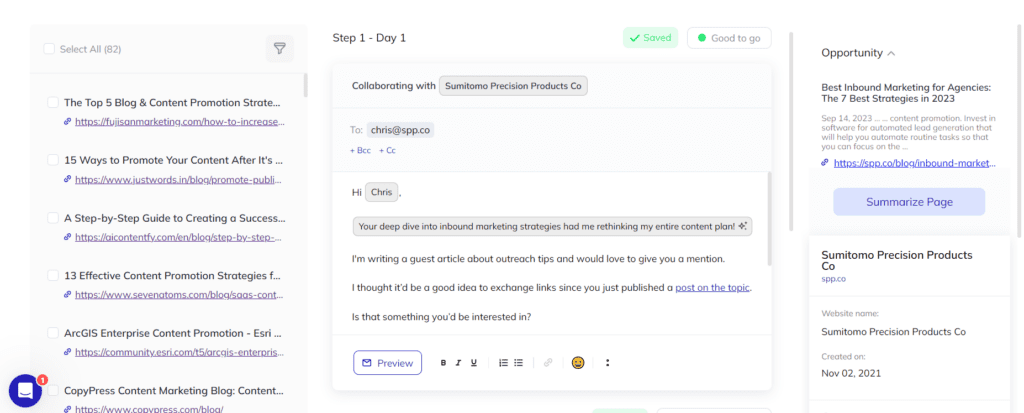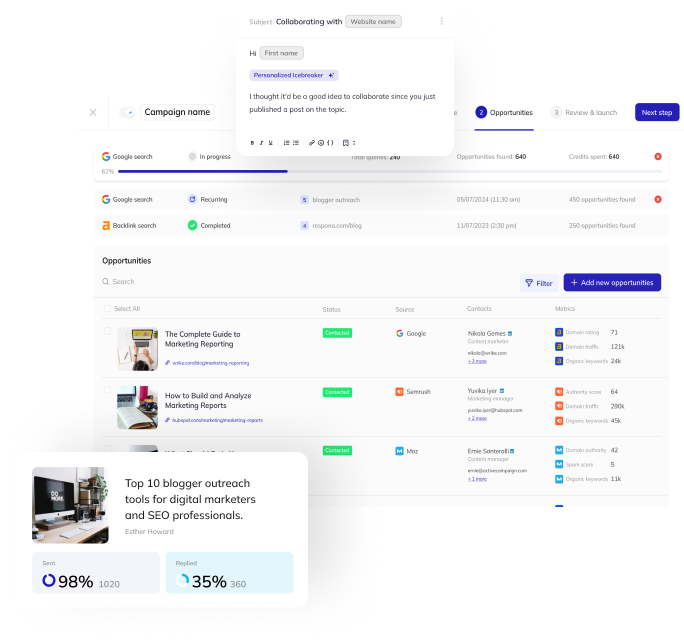The skyscraper technique was first introduced back in 2016 by Brian Dean of Backlinko and then popularized by other figures like Neil Patel.
In this guide, you’ll learn how to apply it to get more quality backlinks and increase your organic traffic.
More specifically, we’re going to cover the following:
- What the skyscraper technique is
- What the purpose of the skyscraper technique is
- Why the skyscraper technique is important for your website
Finally, we’re going to discuss and illustrate a step-by-step process of applying the skyscraper technique using Respona.
Let’s get right into it.
Link building cheat sheet
What is the Skyscraper Technique?
The skyscraper technique focuses on finding the best piece of content out there around a particular keyword and creating something even better with the goal of offering this new content as a valuable backlink to the websites that have linked to old content previously.
If you’re into email marketing and looking to boost the content marketing strategy for either yourself or for a client, then you’ve most likely caught yourself looking for ways to get your skyscraper content ranked as high as possible in the search engine results pages (SERPs), in order to gain more organic traffic.
This is where the skyscraper technique comes in; it’s a simple yet effective way to create better-performing pieces of content.
There are three steps that’ll make the skyscraper technique work:
- Find valuable content that’s already ranking for your target keyword
- Create a piece of high-quality content
- Promote your piece of skyscraper content to the blogs and publications that refer or link back to some of the best performing pieces of content for your target keyword

Let’s break things down.
Step 1: Find great content that already ranks for your target keyword
This means conducting keyword research and finding a good keyword you wish to get ranked high in the SERPs and identifying which content piece is currently the best one out there around that very same term.
The best piece of content is typically one that ranks very high – ideally as the first search engine result – and receives a lot of attention from its target audience.
This would mean that it gets a good amount of organic search traffic, social media shares, comments, and – most importantly – a number of high quality backlinks.

Now that you know which is the best piece of skyscraper content for the term you’re interested in, it’s time to move on to the second step.
Step 2: Create something even better
To execute this step, you’ll have to create a piece of content that’s ultimately better than the current best one out there.
Remember – you want to be the tallest skyscraper or it doesn’t work.
This means providing readers with better, and even more in-depth information, adding high-quality multimedia that’ll improve user experience, and anything else that’ll make your new content more fun, interesting, and engaging.
The purpose of all this is to create the competitive content piece out there around your target keyword.
However, one thing that’s a major search engine ranking factor in the eyes of Google Analytics – and the essence of a successful skyscraper technique – is creating a solid link building strategy based on acquiring the backlinks the current best content has.
This leads us to our third and final step.
Step 3: Promote your content
This step is of vital importance; it’s essential to creating an exceptional content piece based on the skyscraper technique.
In addition to competitive content creation, you must promote it to relevant websites that have previously linked to the resource that had been considered the best and ask them to link back to yours, which is the better alternative.
You can do that by finding the email address of the right person behind each of those websites and sending them high-quality outreach emails.
All of this activity is with the end goal of recognizing your piece as the best one for the keyword and linking back to you.
Simply make sure that the backlinks you find are indeed relevant and valuable to you.
Overall, those are the steps to executing the skyscraper technique.
Let’s have a look at an example of a blog post that has taken advantage of it in order to create the best content out there.
We’ll look at Fundera’s blog post on the topic of small business grants for women.
One thing that differentiates it from other high-ranking content is the use of great images and infographics, as shown below.

A different picture has been designed for each of the grants, thus helping users visually understand what the piece is all about.
Now, let’s have a look at what another piece of relevant content looks like which also ranks high in Google for the same target term.

Straight away, you can see the difference between the two when it comes to readability levels and the overall user experience, which consequently has an impact on search engine optimization as well.
The team behind Fundera also designed an infographic to improve the quality of the existing content, making it significantly better than almost all of the other pieces in the SERPs.

Now let’s see how well this piece performs organically.
As you can see from the screenshot below, starting in March 2019 when the piece was published, the organic traffic has been growing at a good rate and even reached over 20k visits each month.

The same thing applies to the organic keywords when – at its peak – the piece was ranking for over 1.5k keywords in the top 100 organic search results.

When it comes to the traffic value, around the same period the organic traffic peaked at over 20k monthly visits, the traffic was valued at over $45k.
This is the estimated value of the traffic if it had been acquired through a PPC campaign.

This all adds up to say that – despite the ups and downs – this is a great piece of link worthy content and a good case of the skyscraper technique.
Author’s Note: We can’t be sure that the website owner has indeed used the skyscraper technique, meaning we don’t know that they’ve reached out to other important websites asking them to include a link to their resource. We’re using this example to show you that the difference in the quality of a piece of similar content can have great results for its organic performance.
What’s particularly interesting about this piece is the number of keywords it ranks for.

As you can see above, there are keywords like “small business grants for women”, “woman in business grant”, and many more for which the content ranks in the top ten search engine results.
It’s pretty clear that applying the skyscraper technique – or certainly the first two steps – can really help a piece of content outperform competitors and attract valuable traffic.
As we talked about in step three, an important aspect of the skyscraper method is also amazing for link building to your engaging content.
You can do that either by reaching out to other websites you’re interested in or simply by letting them find you on their own and deciding whether what you’ve created is link-worthy content.
Ideally, you can do both.
According to the published case study by SiegeMedia around this particular piece, they helped Fundera acquire 66 high quality links for it.
Actually, if you take a look at the backlink history, there’s a big spike in new backlinks around July 2020.

As you can see from the screenshot we looked at a moment ago, this had a positive consequence on the organic keywords the original content ranked for as well.

So far, it’s pretty clear that applying the skyscraper technique can prove to be very valuable for a piece of content.
Let’s see exactly why.
Why is the Skyscraper Technique Important?
The SEO skyscraper technique is very important because it helps you build an awesome content idea that stands out on the SERP and attracts valuable traffic, quality backlinks, shares on social media, and comments from readers of your content.
Like we covered earlier, a vital factor for this method to work is the link building benefits that come along with it.
Creating a piece of high quality content that’s informative and user-friendly is essential, but nowadays skyscraper link building play a major role in ranking higher in the search engines.
According to a study by Backlinko, pages with many backlinks rank higher than pages with not as many.
To be precise, the first search result in Google has, on average, 3.8 times more backlinks than the rest of the first page results.

Pretty impressive, right?
What’s important to point out is that backlinks and social media shares themselves aren’t necessarily valuable; they should be relevant to your content and from high-authority websites.
That’s what makes them valuable.
You can see whether a website is of high authority or not by looking at its DR, also known as domain authority.
The higher the DR, the more valuable the backlinks you receive from it will be.
In turn, this will slowly increase your own website’s DR, thus giving you more authority and helping you rank higher in the SERPs.
That’s exactly why it’s important to actively acquire backlinks for your skyscraper content.
One of the most effective ways to do that is to use an email outreach tool like Respona, in order to reach out to people who are already linking back to the top-performing competitor content which you want to compete against and ask them to link back to you instead.
That way, you’ll create a high-quality list of link prospects who you’ll know for sure are interested in pieces of content around that particular topic.
Let’s talk more about the purpose of the skyscraper technique.
What is the Purpose of the Skyscraper Technique?
The purpose behind the skyscraper SEO technique is to find the best content around a keyword, create something that’s even better, and then acquire as many backlinks as you can that are already linking back to that best piece of content.
By doing that, you’ll get plenty of benefits for your website.
First of all, since your new content will be the best one out there and ranked very high in the SERPs, you’ll receive a good amount of organic traffic which can then be converted to customers, users, or subscribers.
You also increase your content’s interactions, such as social shares and comments, thus giving you more exposure and slowly establishing your site as an authority in your field, which is great for brand awareness, public relations, organic traffic, and your business’ well-being in general.
Sounds good, right?
What’s more, by actively acquiring backlinks you create relationships with editors, influencers, and bloggers who might prove to be useful in the long run when you want to receive more backlinks for other pieces of content, too.
All in all, there are many benefits when deciding to apply the skyscraper technique.
The ultimate purpose of it, however, is managing to outperform the best competitive pieces out there and ranking as high as possible in the SERPs.
To achieve that, creating better content is not enough; you must promote it as much as you can via a solid link-building & content strategy.
Skyscraper Technique Challenges
While the skyscraper technique can be a game-changer for your content strategy, it’s not without its challenges.
First off, creating content that truly stands out can be easier said than done.
It’s not just about adding more information but about enhancing the reader’s experience with improved design, multimedia elements, and interactive features.
This requires time, effort, and sometimes additional resources to ensure your content is head and shoulders above the rest.
Then there’s the task of thoroughly analyzing your competition.
Identifying what makes their content tick and finding opportunities for improvement demands a keen eye and a strategic mindset.
Promotion is another area where many might stumble.
Even with killer content, a robust distribution strategy is essential. Reaching out for backlinks involves finding the right contacts, crafting engaging outreach emails, and navigating the inevitable rejections.
Persistence and a personal touch in your communication can make a big difference here.
Convincing site owners to update their links in favor of yours can be challenging, requiring you to build genuine relationships and provide clear value.
Moreover, keeping your skyscraper content relevant over time is a continuous endeavor. As the market evolves, your content may need regular updates to maintain its standing as the go-to resource for your target keyword.
The technique also has its limitations with scale and scope. It works best for specific and niche topics where in-depth coverage is feasible. For broader subjects, you might find yourself competing with a sea of high-quality articles, making it tougher to shine.
Let’s now see how you can apply the skyscraper technique step-by-step using our very own tool, Respona.
4 Simple Steps for Applying the Skyscraper Technique
We’ve talked in-depth about what the skyscraper technique is and why it’s important in terms of content marketing.
In this section, we’re going to take you through the process of applying this link-building technique to the promotion of your own content in the most efficient way.
To illustrate the process and make it easier for you to see its practicality, we’re going to use a hypothetical example.
More specifically, we’re going to find links of competing articles – and use them as opportunities for promoting your own content.
In this case, we’re looking to promote a concise and valuable guide we published earlier in 2021 on podcast marketing.

Plus, we’re going to explain the step-by-step process of reaching out to link prospects using Respona.
Let’s get into it.
Step #1: Create Your Skyscraper Techique Campaign
For this campaign, we’ll be using our own tool, Respona.
It’s natively integrated with Moz and can pull your competitors’ backlinks even if you don’t have an account with any backlink monitoring tool.
However, if you do have an account with either Moz, Semrush, or Ahrefs site explorer, you can connect it to Respona and use it as a search source instead.
Respona also has a pre-built campaign template for the Skyscraper Technique.

To use it, fill out 5 simple fields:
- The URL of the skyscraper article you’d like to build links to
- The primary keyword your article targets
- URLs of competing articles
- A brief description of your content
- An incentive for your prospect to include your link (such as an indirect link back)
All fields except for the third one will be pulled into your email sequence.
Respona will automatically pull the backlinks of all URLs you paste in the third field.
Click “Use this template” to create your campaign.
Step #2: Review Your Email Sequence
Because we used a campaign template, our email sequence is already set up.
But, we recommend creating your own template tailored for your specific situation.
Respona’s email sequence builder comes with a whole set of tools to aid you with this process.
First up, it comes with a reply chance calculator:

It works but checking your subject and body length, question count, the number of links you have in your email, as well as numbers and spam words.
The suggestions provided by this calculator are based on millions of emails sent through Respona, and their open/reply rates.
Next, Respona offers automatic follow-ups.

By default, every email sequence template comes with a single follow-up set to seven days after the initial message.
You can change the number and delay between follow-ups, but we recommend sticking to one-two follow-ups spaced out with 3-5 business days to not overwhelm your prospects.
Next, Respona offers you an option to an an unsubscribe link to your emails:

We recommend adding unsubscribe links to your sequences since it provides your prospects a way to stop further communications from you if they are not interested.
Not only will this reduce the number of negative responses in your inbox, but will also reduce the number of manual spam complaints, helping protect your sender reputation.
Last but not least, Respona comes with an extensive set of variables as well as the ability to create your own.

These variables include things like “first_name”, “website_title” and other auto-populating variables that you might expect from an email tool.
But that’s far from it!
Respona features AI-powered variables like the Icebreaker that will generate unique personalizations for every opportunity in your campaign for you – all you have to do is review them.
It does so by “reading” your prospects’ content and pulling interesting points they discussed.
You can provide the AI with additional instructions regarding tone and style, as well as personalization examples to make it sound more like you. More on that in the next step.
Once your email sequence is complete, click “Next step” to get into Respona’s search engine.
Step #3: Start the search automations
Once again, because we used a campaign template and already pasted competing URLs, the search engine is already primed to extract their backlinks and add them directly into your outreach campaign.

If you have connected an Ahrefs or Semrush account to Respona, you can choose it as a search source here to save on Respona credits.
By default, Respona will pull backlinks through our integration with Moz, and charge you Respona credits for every result.
You don’t need to do much here besides click “Continue” and add some SEO fitlers to make sure only relevant opportunities are pulled into your campaign.

Think Domain Authority, Spam Score and Page authority if you’re feeling picky.
Click “Continue” once more and you’ll be brought into the contact finder and AI personalization settings.
Respona runs these three processes at once to save time:
- Extracting backlinsk from your competitors
- Finding relevant contact information to reach out to
- Populate AI personalizations

Since we used the template, the contact finder is pre-set to find all personnel relevant to our purpose – link building.
This includes content and SEO managers, writers, and other creatives.
However, you’re more than welcome to rearrange the search by inputting new job titles and seniority levels into the corresponding fields.
We also recommend keeping the “Skip catch-all domains” and “Use generic emails as needed” options on to increase the success rate of the contact search, while avoiding emails that are not fully verified.
In the next field, you may provide the AI personalizer with additional instuctions.
Before running the automation, there is one final setting you may toggle.

And that is to make your search recurring.
After enabling it, Respona will automatically re-run your searches and add any new opportunities that may have popped up in the meantime, on auto-pilot.
So, all you’ll have to do is check your campaign every once in a while and launch new emails.
Once you start the automation, results will start appearing on the screen in real-time, along with their contact information.

All of it is done in the cloud and you don’t have to wait for the automation to complete.
In the meantime, you can move on to a different campaign or another task.
Respona will send you an email once the automation is complete. Then, you can move on to the final step.
Step #4: Review & Launch
Here, all of your variables (both regular and AI-powered), will be populated.
You can review them and make manual adjustments when necessary.

In addition to email accounts, Respona also looks for your prospects LinkdIn addresses – which will be visible in the opportunity information on the right side.
We recommend sending your prospects a connection request on socials in addition to your email to put a face to your outreach.

Once all emails are personalized and your connection requests sent, Respona will run a final round of pre-launch checks to make sure all variables are populated and you’re not trying to reach out to any contacts in your unsubscribe list or ones that are already active in one of your other campaigns.
Here, you can also change your sending schedule, select your sender emails, and change the sending strategy to send-all, CC, or no-reply.

After your campaign is launched, all you have to do is look out for responses and manage your conversations.
Even here, Respona’s got your back.
Our shared inbox brings all of your email accounts into a unified interface, so you don’t have to juggle multiple tabs just to check all of your inboxes.

Download Our Skyscraper Checklist
As you know by now, applying the skyscraper technique can help you take your content & SEO strategy to the next level.
However, it does include several steps, a fact that might make you feel intimidated.

From finding the right popular topic to cover and coming up with the best and most promising content ideas, to writing a well-curated piece of popular content that’ll increase your success rate and maximize your chances of getting links back to your resource – we’ve covered it all.
Plus, the skyscraper technique also requires efficient outreach and the ability to manage communications with your prospects.
That’s why we want to streamline the process for you by creating the checklist you see above.
All you have to do is follow the steps – yes, it’s that easy!
Let’s wrap this up and close with a few final thoughts.
Link building cheat sheet
Now Over to You
That was it.
In this post, we’ve thoroughly covered all about the skyscraper technique that was introduced in 2016 by Backlinko’s Brian Dean.
More specifically, we’ve given you a skyscraper technique definition and have also taken you through the different steps of it.
As you know already, the skyscraper technique can be quite beneficial for various reasons and is important in terms of creating unique content that’ll give you a competitive advantage over competing articles.
Feel free to use our skyscraper checklist to make the most out of this powerful technique and don’t hesitate to start your 14-day free trial with Respona if you want to take your outreach up a notch.
We’d love to hear from you – have you ever used the skyscraper technique? If yes, what were the results? If not, what’s keeping you from using it?






